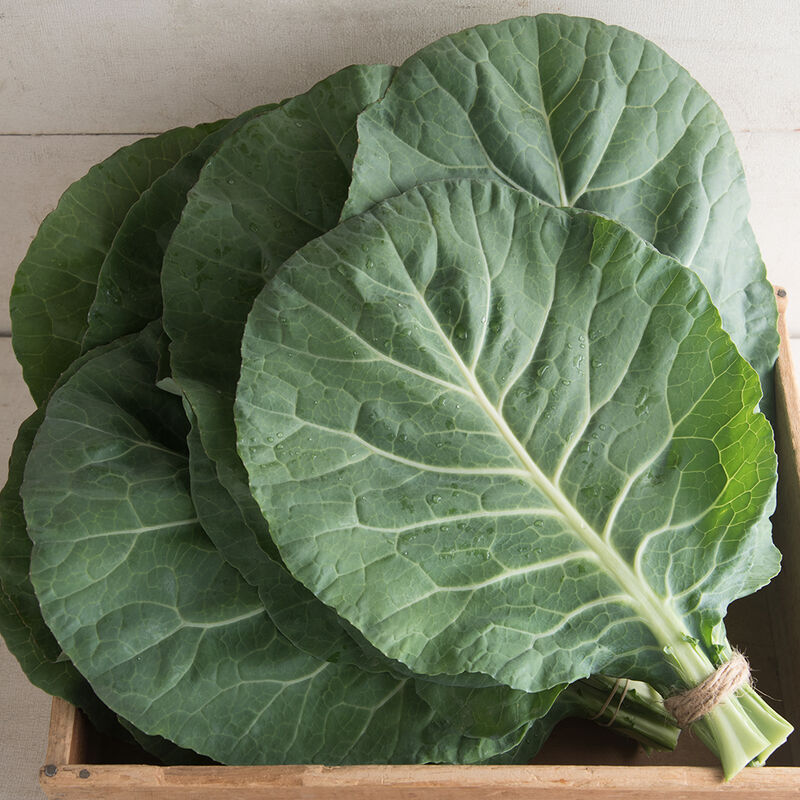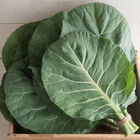Flash (F1) Collard Seed
Product ID:2116.112116.11
Flash (F1) Collard Seed
Product ID:2116.112116.11
Vates-type hybrid.
Very slow to bolt. Flash offers repeated harvests of smooth dark green leaves. Very high yielding.Specs:
- This product does not ship to the following countries: United Arab Emirates, Austria, Australia, Barbados, Belgium, Bulgaria, Bermuda, Bahamas, Switzerland, Cyprus, Czech Republic, Germany, Denmark, Estonia, Spain, Finland, France, United Kingdom, Greece, Hong Kong, Croatia, Hungary, Ireland, Iceland, Italy, Japan, Republic of Korea, Kuwait, Cayman Islands, Lithuania, Luxembourg, Latvia, Malta, Netherlands, Norway, New Zealand, Oman, Poland, Portugal, Qatar, Romania, Saudi Arabia, Sweden, Singapore, Slovenia, Slovakia, San Marino, Thailand, Trinidad and Tobago, Taiwan, Ukraine.
SCIENTIFIC NAME:
Brassica oleraceaCULTURE:
Collards prefer a fertile, well-drained soil high in organic matter with a pH range of 6.0–7.5. Consistent moisture will produce the best quality leaves. In the South, collards are best for fall, winter, and early spring harvests, to avoid the temperature extremes of midsummer—even though they will tolerate some measure of heat. Because collards are very cold tolerant, they also do well in the North, where their flavor is enhanced by frost and cold weather.DAYS TO MATURITY:
From date of direct seeding; subtract about 14 days if transplanting.DIRECT SEEDING:
Plant from early spring to approximately 3 months before expected fall frost. For bunching, sow 3–4 seeds every 12-18", ½" deep, in rows 18–36" apart. Thin to 1 plant per group. For baby leaf production, sow 60 seeds per foot in a 2–4" wide band ¼–½" deep.AVG. DIRECT SEEDING RATE:
For bunching: 1,000 seeds/220', 1 oz./1,110', 1 lb./24,000'.EARLY SPRING CROP:
Sow 2 seeds per cell in 50- to 72-cell plug flats, 3–4 seeds/in. in 20 row flats, or in outdoor beds ¼" deep. Seedlings should be ready to transplant in 4-6 weeks. If possible keep soil temperature over 75°F (24°C) until germination, then reduce air temperature to about 60°F (16°C). Transplant outdoors 12–18" apart in rows 18–36" apart. Collards prefer cooler growing temperatures, between 55–75°F (13–24°C), optimum being 60–70°F (16–21°C), but will produce good crops under warmer, summer conditions.FALL CROP:
Start seedlings as above in May and transplant to the garden in June–July. To ensure mature heads, seed the crop early in areas where heavy freezes occur early in fall.WINTER CROP:
Successful collards crops can be grown where winters are mild (temperatures rarely below 32°F (0°C)). Transplants can be set out from September to February in these regions.INSECT PESTS: The best insect control is achieved with the use of fabric row covers applied at planting, to exclude insects from the plants. DISEASE: Adhere strictly to a preventive program including: (1) long crop rotations with non-brassica crops, (2) clean starting mixes and outdoor seedbeds, and (3) strict sanitation practices. Johnny's Selected Seeds only sells seed lots of collards that have tested negative for black rot (Xanthomonas campestris pv. campestris) and black leg (Phoma lingam). NOTE: A disease-free test result means that in the sample tested, the pathogen targeted was not found. It does not guarantee a seed lot to be disease-free. However, no method of seed treatment can positively insure freedom from disease. We are glad to help with specific questions.HARVEST:
Beginning about 2 months after planting, harvest by clipping individual leaves. Collards are very hardy, and the eating quality will improve into the late fall with light frost. Late summer sown or planted collards can be wintered in cold frames or hoophouses, or in the open in mild regions, to extend the season. Protecting with row covers can extend the harvest period.TRANSPLANTS:
Avg. 4,450 plants/oz.SEEDS/LB. (AVG.):
92,400.PACKET:
100 seeds, sows 22'.Johnny's is committed to your success, every step of the way.
We want you, our customer, to be 100% satisfied with all of our seeds, tools, and supplies.
If anything you purchase from us proves unsatisfactory, we will either replace the item or refund the purchase price.




